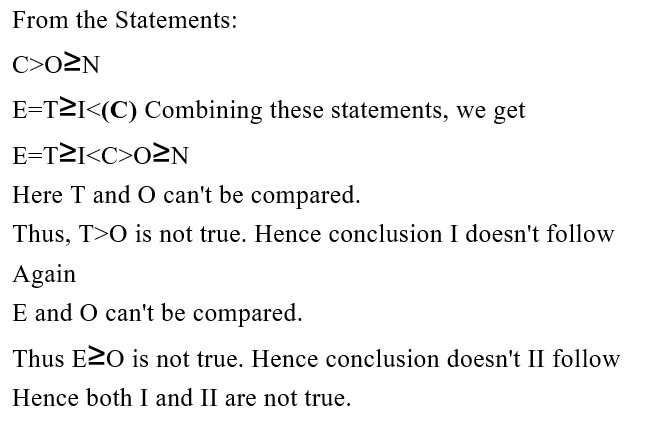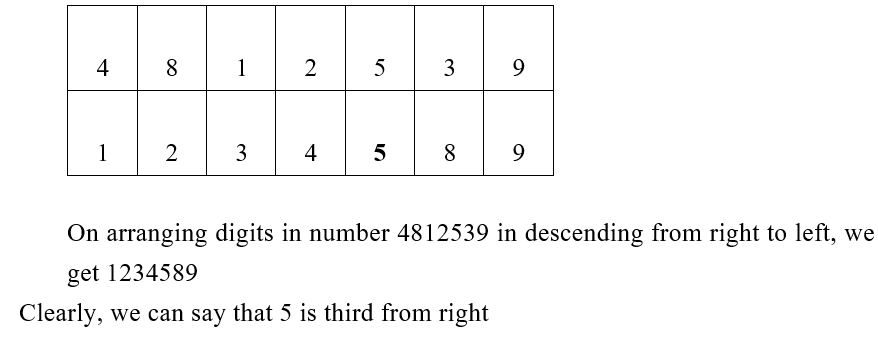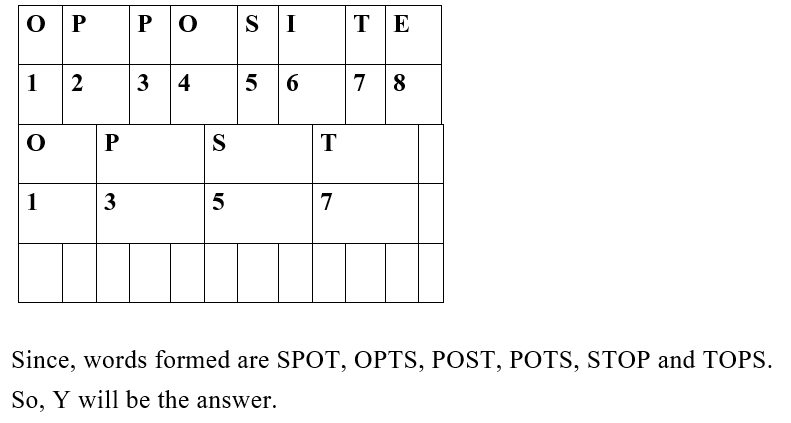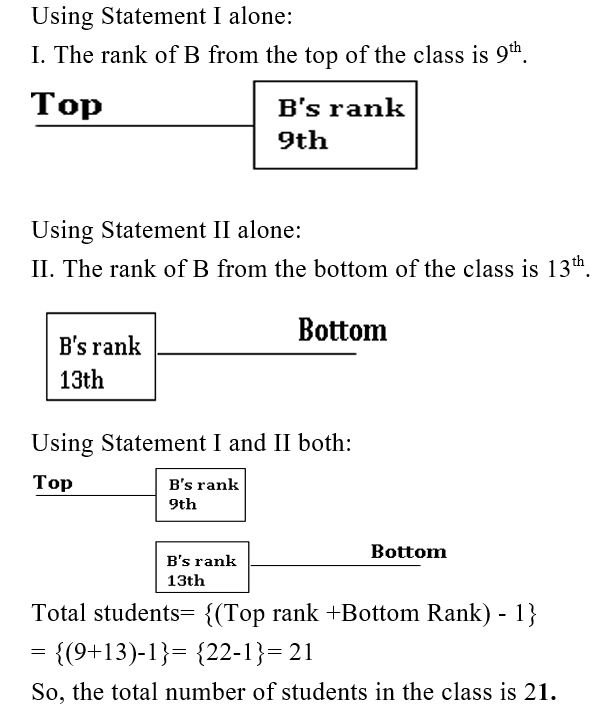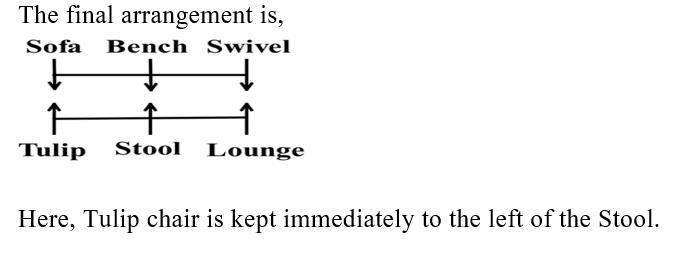Question 1:
In the question relationship between different elements is shown in the statements. The statement is followed by two conclusions. Choose the correct option.
प्रश्न में विभिन्न तत्वों के बीच संबंध कथनों में दर्शाया गया है। कथन के बाद दो निष्कर्ष निकलते हैं। सही विकल्प चुनिए।
Statement:/ कथनः C>O≥N, E=T≥I<C
Conclusion: / निष्कर्षः
I. T>O II. E≥O
Question 2:
Directions: Certain number of persons are sitting in the straight horizontal row facing towards the north direction. The distance between the adjacent persons is equal, and not more than two known persons sit on the adjacent seats. D sits third to the right of K and second to the left of H. Only three persons sit to the right of M. Four persons sit between M and B. Five persons sit between H and T, who sits second from one of the ends of the row. Six persons sit between K and A, who is an immediate neighbour of B.
निर्देश: निश्चित संख्या में व्यक्ति एक सीधी क्षैतिज पंक्ति में उत्तर दिशा की ओर मुखरित होकर बैठे हैं। आसन्न व्यक्तियों के बीच की दूरी बराबर है और दो से अधिक ज्ञात व्यक्ति आसन्न सीटों पर नहीं बैठे हैं। D, K के दायें से तीसरे और H के बायें से दूसरे स्थान पर बैठा है। M के दायें केवल तीन व्यक्ति बैठे हैं। M और B के बीच चार व्यक्ति बैठे हैं। H और T के बीच पाँच व्यक्ति बैठे हैं तथा T पंक्ति के किसी एक अंत से दूसरे स्थान पर बैठा है। K और A के बीच छह व्यक्ति बैठे हैं तथा A, B का निकटस्थ पड़ोसी है।
What is the position of D from the left end of the row?
पंक्ति के बाएं अंत से D का स्थान क्या है?
Question 3:
Directions: Certain number of persons are sitting in the straight horizontal row facing towards the north direction. The distance between the adjacent persons is equal, and not more than two known persons sit on the adjacent seats. D sits third to the right of K and second to the left of H. Only three persons sit to the right of M. Four persons sit between M and B. Five persons sit between H and T, who sits second from one of the ends of the row. Six persons sit between K and A, who is an immediate neighbour of B.
निर्देश: निश्चित संख्या में व्यक्ति एक सीधी क्षैतिज पंक्ति में उत्तर दिशा की ओर मुखरित होकर बैठे हैं। आसन्न व्यक्तियों के बीच की दूरी बराबर है और दो से अधिक ज्ञात व्यक्ति आसन्न सीटों पर नहीं बैठे हैं। D, K के दायें से तीसरे और H के बायें से दूसरे स्थान पर बैठा है। M के दायें केवल तीन व्यक्ति बैठे हैं। M और B के बीच चार व्यक्ति बैठे हैं। H और T के बीच पाँच व्यक्ति बैठे हैं तथा T पंक्ति के किसी एक अंत से दूसरे स्थान पर बैठा है। K और A के बीच छह व्यक्ति बैठे हैं तथा A, B का निकटस्थ पड़ोसी है।
How many persons sit between H and M?
H और M के बीच कितने व्यक्ति बैठे हैं?
Question 4:
Directions: Certain number of persons are sitting in the straight horizontal row facing towards the north direction. The distance between the adjacent persons is equal, and not more than two known persons sit on the adjacent seats. D sits third to the right of K and second to the left of H. Only three persons sit to the right of M. Four persons sit between M and B. Five persons sit between H and T, who sits second from one of the ends of the row. Six persons sit between K and A, who is an immediate neighbour of B.
निर्देश: निश्चित संख्या में व्यक्ति एक सीधी क्षैतिज पंक्ति में उत्तर दिशा की ओर मुखरित होकर बैठे हैं। आसन्न व्यक्तियों के बीच की दूरी बराबर है और दो से अधिक ज्ञात व्यक्ति आसन्न सीटों पर नहीं बैठे हैं। D, K के दायें से तीसरे और H के बायें से दूसरे स्थान पर बैठा है। M के दायें केवल तीन व्यक्ति बैठे हैं। M और B के बीच चार व्यक्ति बैठे हैं। H और T के बीच पाँच व्यक्ति बैठे हैं तथा T पंक्ति के किसी एक अंत से दूसरे स्थान पर बैठा है। K और A के बीच छह व्यक्ति बैठे हैं तथा A, B का निकटस्थ पड़ोसी है।
If T is related to K, in the same way A is related to _____.
यदि T, K से संबंधित है, उसी प्रकार A, _____ से संबंधित है।
Question 5:
Answer the following question based on the below information:
नीचे दी गई जानकारी के आधार पर निम्नलिखित प्रश्न का उत्तर दें:
What would be position of digit '5' if all digits in number 4812539 are arranged in descending order from right to left?
यदि संख्या 4812539 में सभी अंकों को दाएं से बाएं अवरोही क्रम में व्यवस्थित किया जाए तो अंक '5' का स्थान क्या होगा?
Question 6:
If a meaningful word can be formed using the 1st, 3rd, 5th and 7th letters of the word "OPPOSITE" from the left end only once, and then what is the first letter from the right end of the word formed?
If no such word can be formed, then mark V as your answer while if more than one such word can be formed, then mark Y as your answer.
यदि बाईं छोर से "OPPOSITE" शब्द के पहले, तीसरे, पाँचवें और सातवें अक्षरों का उपयोग करके एक सार्थक शब्द बनाया जा सकता है, तो फिर बने हुए शब्द के दाईं छोर से पहला अक्षर क्या है?
यदि ऐसा कोई शब्द नहीं बनाया जा सकता है, तो अपने उत्तर के रूप में V को चिह्नित कीजिए, जबकि यदि एक से अधिक शब्द बन सकते हैं, तो Y को अपने उत्तर के रूप में चिह्नित कीजिए।
Question 7:
How many pairs of letters are there in the word "MAXIMIZES" which has as many letters between them as in the alphabet when counted from both sides?
शब्द "MAXIMIZES" में दोनों ओर से गिनने पर अक्षरों के ऐसे कितने युग्म हैं जिनके बीच उतने ही अक्षर हैं जितने कि उनके बीच वर्णमाला में होते हैं?
Question 8:
The question given below consists of two statements numbered I and II given below it. You have to decide whether the data given in the statements are sufficient to answer the question.
नीचे एक प्रश्न और उसके नीचे दो कथन संख्यांकित I और II दिए गए हैं। आपको यह निर्धारित करना है कि कथनों में दी गई सूचना प्रश्न का उत्तर देने के लिए पर्याप्त है या नहीं।
How many students are there in the class?
कक्षा में कितने विद्यार्थी हैं?
Statement I. The rank of B from the top of the class is 9th.
कथन I. कक्षा में शीर्ष से B का रैंक 9वाँ है।
Statement II. The rank of B from the bottom of the class is 13th.
कथन II. कक्षा में सबसे नीचे से B का रैंक 13वाँ है।
Question 9:
Six types of chairs Bench, Lounge, Sofa, Stool, Swivel and Tulip are kept in two parallel rows such that three chairs are kept in a row facing the north and the rest three chairs are kept in a row facing the south. The tulip is kept opposite to the sofa. The bench is kept at the centre and the swivel is kept immediately to the left of it. The swivel and the tulip are facing the opposite direction. The lounge is kept opposite Swivel and is facing north. Which chair is kept immediately to the left of the Stool?
छह प्रकार की कुर्सियों बेंच, लाउंज, सोफा, स्टूल, स्विवल और ट्यूलिप को दो समांतर पंक्तियों में इस प्रकार रखा गया है कि तीन कुर्सियाँ उत्तर की ओर मुखरित करके एक पंक्ति में रखी गई हैं और शेष तीन कुर्सियाँ दक्षिण की ओर मुखरित करके दूसरी पंक्ति में रखी गई हैं। ट्यूलिप को सोफे के विपरीत रखा गया है। बेंच को केंद्र में रखा गया है तथा स्विवल को बेंच के निकटस्थ बाईं ओर रखा गया है। स्विवल और ट्यूलिप विपरीत दिशाओं की ओर मुखरित हैं। लाउंज को स्विवल के विपरीत रखा गया है और लाउंज उत्तर की ओर मुखरित है। स्टूल के निकटस्थ बाईं ओर कौन-सी कुर्सी रखी गई है?
Question 10:
Which of the following should replace the question mark so that W>Z is definitely true, and X=U is not definitely false?
निम्नलिखित में से कौन-से विकल्प द्वारा प्रश्न चिह्न को प्रतिस्थापित किया जाना चाहिए ताकि W>Z निश्चित रूप से सत्य हो और X=U निश्चित रूप से असत्य न हो?
Z ≤ Y < X ? W = V ≤ U

